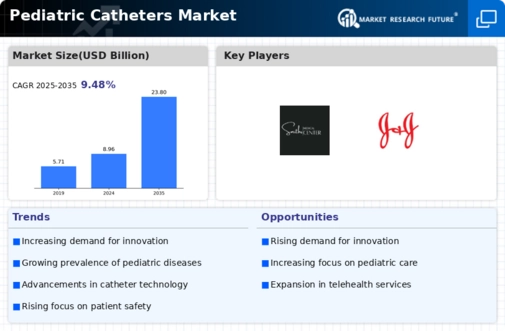Technological Innovations
Technological advancements in catheter design and materials are significantly influencing the Pediatric Catheters Market. Innovations such as biocompatible materials and advanced manufacturing techniques are enhancing the safety and efficacy of pediatric catheters. For instance, the introduction of catheters with antimicrobial coatings has been shown to reduce infection rates, which is a critical concern in pediatric care. Additionally, the development of smaller, more flexible catheters allows for easier insertion and greater comfort for young patients. These technological improvements not only enhance patient outcomes but also encourage healthcare facilities to adopt newer products, thereby driving growth in the Pediatric Catheters Market.
Increasing Pediatric Population
The rising pediatric population is a crucial driver for the Pediatric Catheters Market. As the number of children requiring medical interventions increases, the demand for pediatric catheters is likely to grow. According to recent demographic data, the population of children under the age of 18 is projected to rise steadily, leading to a higher incidence of conditions that necessitate catheterization. This trend suggests that healthcare providers will need to invest in specialized pediatric catheters to cater to this expanding demographic. Furthermore, the increasing awareness among parents regarding pediatric health issues may also contribute to the demand for these medical devices, thereby propelling the Pediatric Catheters Market forward.
Enhanced Focus on Pediatric Healthcare
There is an increasing emphasis on pediatric healthcare, which is driving the Pediatric Catheters Market. Governments and healthcare organizations are recognizing the need for specialized medical devices tailored to children. This focus is reflected in policy initiatives aimed at improving pediatric care standards and increasing funding for pediatric health programs. As a result, healthcare providers are more likely to invest in pediatric-specific products, including catheters. The growing recognition of the unique healthcare needs of children is likely to lead to a more robust market for pediatric catheters, as stakeholders prioritize the development and distribution of these essential medical devices.
Regulatory Support for Pediatric Devices
Regulatory bodies are increasingly supporting the development of pediatric medical devices, which is beneficial for the Pediatric Catheters Market. Initiatives aimed at expediting the approval process for pediatric-specific products are encouraging manufacturers to innovate and bring new catheters to market. This regulatory support is crucial, as it not only enhances the availability of specialized devices but also ensures that they meet safety and efficacy standards. As a result, healthcare providers are more inclined to adopt these products, knowing they have undergone rigorous evaluation. This trend is likely to stimulate growth in the Pediatric Catheters Market, as more pediatric catheters become accessible to healthcare facilities.
Rising Incidence of Congenital Disorders
The increasing prevalence of congenital disorders is a significant factor propelling the Pediatric Catheters Market. Conditions such as congenital heart defects and urinary tract malformations often require catheterization for effective management. Recent studies indicate that approximately 1 in 33 infants is born with a congenital anomaly, necessitating specialized medical interventions. As healthcare systems strive to provide better care for these patients, the demand for pediatric catheters is expected to rise. This trend underscores the importance of developing catheters that are specifically designed for the unique anatomical and physiological needs of children, thereby fostering growth in the Pediatric Catheters Market.

















Leave a Comment